By Guido Mina di Sospiro (April 2019)
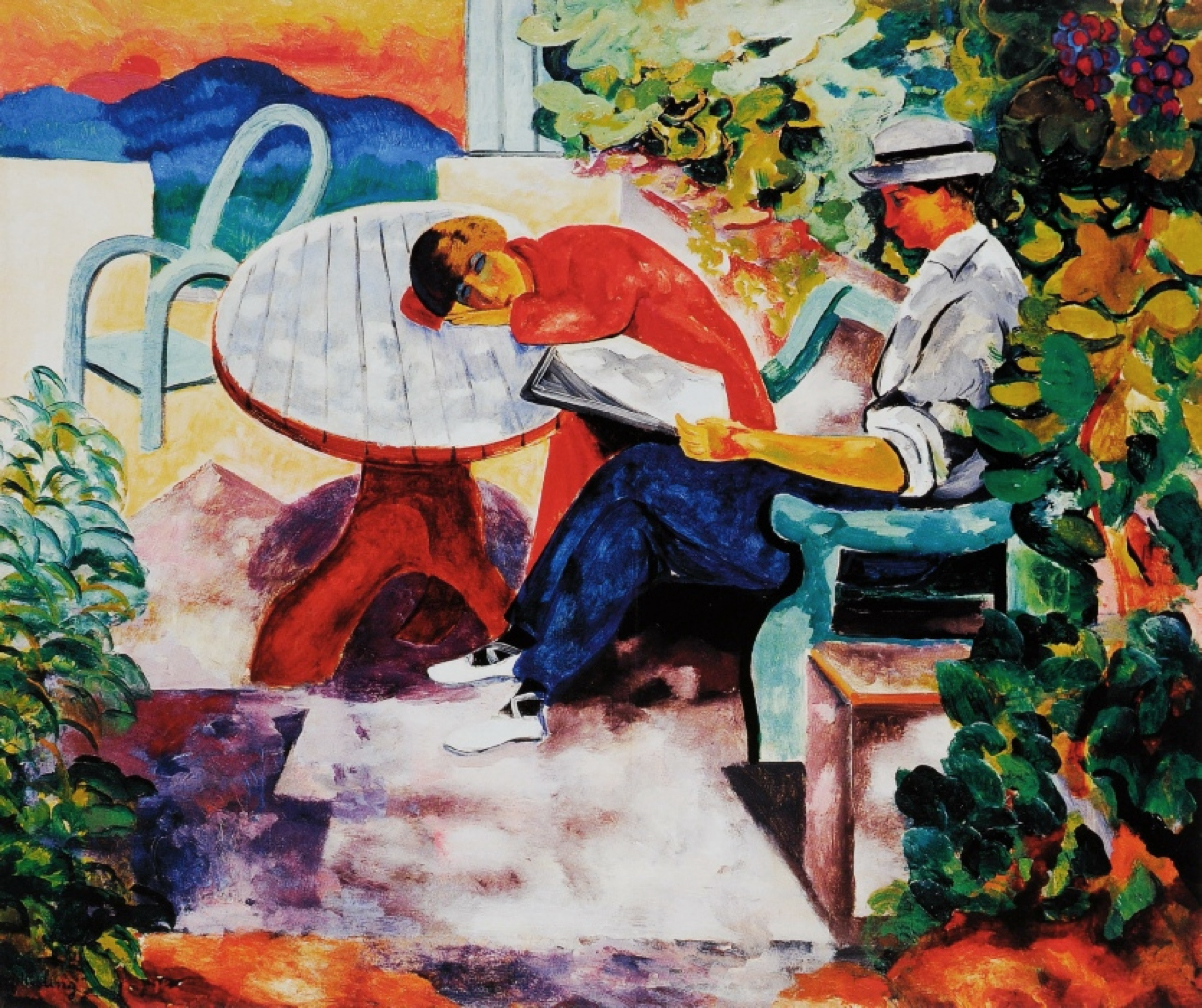
La Sieste à Saint-Tropez (Kisling with Renée), Moïse Kisling, 1916
Millions take daily doses of vitamins and sundry supplements (who could do without, among others, Acai berries and Reishi powder?). I take doses of mainstream-avoidance therapy as often as I can, which means also at night. There are two big piles of books on my nightstand, tomes that vie for my attention and that I read in dribs and drabs. Most, though not all, come from second-hand bookshops, which I tend to patronize since in the “normal” ones the mainstream propaganda is so inescapable, they have become one of its official vehicles.
A selection of the books currently on my nightstand may catch your fancy, too. In no particular order:
El horror de Dunwich (The Dunwich Horror), by H.P. Lovecraft.
 Considered to be at the core of the fictional universe of the Cthulhu Mythos, this short story seems like Lovecraft’s every story as far as the reaction they provoke in the reader: from, “Is this monstrous?” to, “It is monstrous!” to, finally, “My God, it is inconceivably monstrous!” In addition to that, his prose is indigestible: so very mannered that sometimes it comes off as a parody. The saving grace comes when Lovecraft’s work is translated into a Romance language. I’ve read Lovecraft in Italian and in Castilian, as with this particular book, and his prose becomes more elegant and less heavy simply because Romance languages are more parenthetical and better support long-winded periods. I bought El horror de Dunwich in Urueña, la Villa del Libro, or Bookville, in Castilla y Léon, in central Spain. There are more bookshops in it than cafés. Situated on top of a hill, surrounded by ancient fortified walls, it’s a place in which any bibliophile likes to get lost. With Lovecraft’s prose restored to better readability thanks to its being translated into Romance languages, I can see why he has become part of the current belief in ancient aliens and the prehistoric manipulation of humanity; so much so, in fact, that he is perceived as an inadvertent clairvoyant.
Considered to be at the core of the fictional universe of the Cthulhu Mythos, this short story seems like Lovecraft’s every story as far as the reaction they provoke in the reader: from, “Is this monstrous?” to, “It is monstrous!” to, finally, “My God, it is inconceivably monstrous!” In addition to that, his prose is indigestible: so very mannered that sometimes it comes off as a parody. The saving grace comes when Lovecraft’s work is translated into a Romance language. I’ve read Lovecraft in Italian and in Castilian, as with this particular book, and his prose becomes more elegant and less heavy simply because Romance languages are more parenthetical and better support long-winded periods. I bought El horror de Dunwich in Urueña, la Villa del Libro, or Bookville, in Castilla y Léon, in central Spain. There are more bookshops in it than cafés. Situated on top of a hill, surrounded by ancient fortified walls, it’s a place in which any bibliophile likes to get lost. With Lovecraft’s prose restored to better readability thanks to its being translated into Romance languages, I can see why he has become part of the current belief in ancient aliens and the prehistoric manipulation of humanity; so much so, in fact, that he is perceived as an inadvertent clairvoyant.
The Rivers Ran East, by Leonard Clark.
 Ah, the good old days in which an explorer did explore the . . . unexplored. Nowadays, with nothing left to explore, adventure travelogues have turned into chronicles of bizarre undertakings, such as, say, climbing Mount Everest with no oxygen, backwards, and blindfolded to boot. “East of the Peruvian Andes,” reads the book’s flap, “lies the vast rain-forest of the Gran Pajonal, laced with white-water rivers and inhabited by savages to whom torture and death are everyday matters.” Really? Well, I’d better read on, the publishers must have assumed readers would think. And, back then, they did. Published in 1953, the adventures in it date back to 1949 and are, by contemporary standards, incredible. Also refreshing-if-not-comical in their candor are passages such as the following one. “It has been established that prior to the discovery of America and the ancient Incas, syphilis was unknown in Europe. Nearby pre-Colombian Incan graves were at the moment producing—under the spades of a Lima scientist—the bones of syphilitics, due, he believed, to the Andean Indians’ working with llamas and the ancient instinct for sodomy. Very likely humanity owes this curse to Pizarro and the Andean llama. There was a national law which forbade any male Indian from traveling with a herd of llamas on a trip exceeding twenty-four hours, unless a woman went along. And since all available women were working shifts in the mines, the llama trains were stalled indefinitely.”
Ah, the good old days in which an explorer did explore the . . . unexplored. Nowadays, with nothing left to explore, adventure travelogues have turned into chronicles of bizarre undertakings, such as, say, climbing Mount Everest with no oxygen, backwards, and blindfolded to boot. “East of the Peruvian Andes,” reads the book’s flap, “lies the vast rain-forest of the Gran Pajonal, laced with white-water rivers and inhabited by savages to whom torture and death are everyday matters.” Really? Well, I’d better read on, the publishers must have assumed readers would think. And, back then, they did. Published in 1953, the adventures in it date back to 1949 and are, by contemporary standards, incredible. Also refreshing-if-not-comical in their candor are passages such as the following one. “It has been established that prior to the discovery of America and the ancient Incas, syphilis was unknown in Europe. Nearby pre-Colombian Incan graves were at the moment producing—under the spades of a Lima scientist—the bones of syphilitics, due, he believed, to the Andean Indians’ working with llamas and the ancient instinct for sodomy. Very likely humanity owes this curse to Pizarro and the Andean llama. There was a national law which forbade any male Indian from traveling with a herd of llamas on a trip exceeding twenty-four hours, unless a woman went along. And since all available women were working shifts in the mines, the llama trains were stalled indefinitely.”
Read more in New English Review:
• Europe
• Letter from Berlin
• Libertarianism VS Postmodernism and Social Justice Ideology
Back to God’s Country, by James Oliver Curwood.
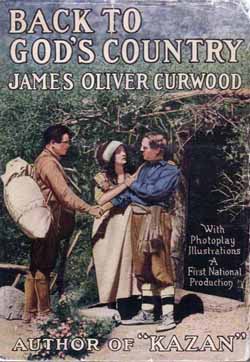 In the DC area, the BIG sales (Books for International Goodwill) are unmissable. Tens of thousands of books are on the shelves, priced at $3 for hardbacks, $2 for trade soft-bound, and $1 for pocket paperbacks. How does this work? “B.I.G. collects over 1,000 books per day most of which are sent to under-served parts of the world to keep these books alive and to assist in the growth of education and culture in developing countries. Books not suitable for these shipments are offered for sale to local residents. Proceeds from book sales pay for shipments of books overseas to communities building their local libraries.” Always on the lookout for oldish books, though I have noticed down the years that they are harder to come by, I picked up, among others, Curwood’s Back to God’s Country, a collection of short stories about animals, humans and harsh elements in the Great North, with its original cover, which is rare for a book published a century ago, as well as its slightly musty aroma, which I welcome, as I buy books also in accordance to their smell. Other than that, I thought Curwood might be just some hack ripping off Jack London. I stand corrected: an ante litteram advocate of environmentalism, he was one the best-selling authors of the 1920s, and at least eighteen films have been based on his stories. Back to God’s Country (1919) was the most successful silent film in Canadian history. It features, incidentally, one of the first nude scenes in cinema history. The protagonist of the film was oddly changed: from the Great Dane to Dolores, a human female lead—much to Curwood’s chagrin.
In the DC area, the BIG sales (Books for International Goodwill) are unmissable. Tens of thousands of books are on the shelves, priced at $3 for hardbacks, $2 for trade soft-bound, and $1 for pocket paperbacks. How does this work? “B.I.G. collects over 1,000 books per day most of which are sent to under-served parts of the world to keep these books alive and to assist in the growth of education and culture in developing countries. Books not suitable for these shipments are offered for sale to local residents. Proceeds from book sales pay for shipments of books overseas to communities building their local libraries.” Always on the lookout for oldish books, though I have noticed down the years that they are harder to come by, I picked up, among others, Curwood’s Back to God’s Country, a collection of short stories about animals, humans and harsh elements in the Great North, with its original cover, which is rare for a book published a century ago, as well as its slightly musty aroma, which I welcome, as I buy books also in accordance to their smell. Other than that, I thought Curwood might be just some hack ripping off Jack London. I stand corrected: an ante litteram advocate of environmentalism, he was one the best-selling authors of the 1920s, and at least eighteen films have been based on his stories. Back to God’s Country (1919) was the most successful silent film in Canadian history. It features, incidentally, one of the first nude scenes in cinema history. The protagonist of the film was oddly changed: from the Great Dane to Dolores, a human female lead—much to Curwood’s chagrin.
Forgotten Civilizations, by Robert. M. Schoch.
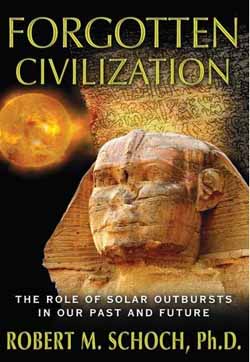 Whenever I find myself in Sedona, Arizona, I drive twenty miles south to Cottonwood, where David Hatcher Childress, the real-life Indiana Jones, has one of his Adventures Unlimited bookstores. During my latest visit I nearly sacked the place. Among many pearls is Schoch’s Forgotten Civilizations. Changing our understanding on the origins of civilization is no small achievement, but Schoch gradually builds up a convincing case. “Blasphemy!” mainstream archeologists scream in unison; what further irritates academe is that this is not the work of a charlatan, but of a fellow academician, from Boston University, with a Ph.D. from Yale University. “He ought to know better!” is a frequent criticism moved to him by less outraged but equally disapproving colleagues. The same, if in other branches of knowledge, happens to Rupert Sheldrake, James Stevens Curl, Joscelyn Godwin and others. Such scholars are all perceived as renegades. But, since the truth does not care about affiliations, cliques, preconceived notions and assumptions, such attacks by academe are only to be interpreted as a good sign.
Whenever I find myself in Sedona, Arizona, I drive twenty miles south to Cottonwood, where David Hatcher Childress, the real-life Indiana Jones, has one of his Adventures Unlimited bookstores. During my latest visit I nearly sacked the place. Among many pearls is Schoch’s Forgotten Civilizations. Changing our understanding on the origins of civilization is no small achievement, but Schoch gradually builds up a convincing case. “Blasphemy!” mainstream archeologists scream in unison; what further irritates academe is that this is not the work of a charlatan, but of a fellow academician, from Boston University, with a Ph.D. from Yale University. “He ought to know better!” is a frequent criticism moved to him by less outraged but equally disapproving colleagues. The same, if in other branches of knowledge, happens to Rupert Sheldrake, James Stevens Curl, Joscelyn Godwin and others. Such scholars are all perceived as renegades. But, since the truth does not care about affiliations, cliques, preconceived notions and assumptions, such attacks by academe are only to be interpreted as a good sign.
La gran aventura del reino de Asturias: Asì empezò la Reconquista, by José Javier Esparza.
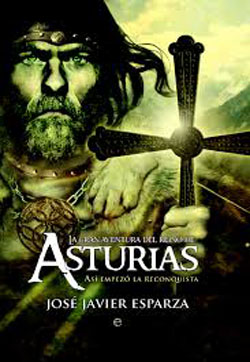 In Cangas de Onís, in Asturias, Northern Spain, I bought this book by the one-eyed essayist and cultural critic Esparza, who is making a career out of historical revisionism. This particular book proudly announces on its cover to have reached the eight edition, and probably more since then (September 2016). Like other former colonial empires, Spain, after the end of Francoism in 1975, has gone through a period of acute guilt feelings about its past. Unlike the United Kingdom, however, a countertrend has come into being, thanks to which Spain’s complex and rich history is being reevaluated; some Spaniards are beginning to find pride once more in their heritage. Asturias is the only region in Spain that was never captured by the Moors; the Re-conquest, which culminated eight centuries later with the expulsion of the Moors from the Iberian Peninsula, began in that remote and mountainous kingdom, led by Visigothic royalty. We have all been told that the Moors from Spain kept culture alive during the Dark Ages, when the rest of Europe was asleep at best. Actually, culture was revived by the Carolingian Renaissance (after Charles Martel defeated the Saracen army) and kept alive by thousands of monks and friars in monasteries all over the continent who transcribed ancient manuscripts, until the latter were restored to prominence in the High Middle Ages in Italy, and then elsewhere. The Moors produced numerous second-rate dabblers in Aristotelian philosophy, and not much else; never any music or figurative art, of course, as they were both forbidden by the Koran. Some will say that the architectural heritage the Moors left behind in Spain is noteworthy, but the pre-Romanesque miniature churches that the early kings of the Asturias managed to build around Oviedo as the first statements of undying Christianity are touching, while so many of the squares and public spaces, religious and university buildings, palaces and palatial houses that Spain created down the centuries as the Re-conquest moved from north to south are utterly stunning. What La gran aventura del reino de Asturias explains in detail is how the Moors behaved, in fact, as all invading barbarians do, by sacking, plundering, raping, murdering, and burning to the ground everything in their path.
In Cangas de Onís, in Asturias, Northern Spain, I bought this book by the one-eyed essayist and cultural critic Esparza, who is making a career out of historical revisionism. This particular book proudly announces on its cover to have reached the eight edition, and probably more since then (September 2016). Like other former colonial empires, Spain, after the end of Francoism in 1975, has gone through a period of acute guilt feelings about its past. Unlike the United Kingdom, however, a countertrend has come into being, thanks to which Spain’s complex and rich history is being reevaluated; some Spaniards are beginning to find pride once more in their heritage. Asturias is the only region in Spain that was never captured by the Moors; the Re-conquest, which culminated eight centuries later with the expulsion of the Moors from the Iberian Peninsula, began in that remote and mountainous kingdom, led by Visigothic royalty. We have all been told that the Moors from Spain kept culture alive during the Dark Ages, when the rest of Europe was asleep at best. Actually, culture was revived by the Carolingian Renaissance (after Charles Martel defeated the Saracen army) and kept alive by thousands of monks and friars in monasteries all over the continent who transcribed ancient manuscripts, until the latter were restored to prominence in the High Middle Ages in Italy, and then elsewhere. The Moors produced numerous second-rate dabblers in Aristotelian philosophy, and not much else; never any music or figurative art, of course, as they were both forbidden by the Koran. Some will say that the architectural heritage the Moors left behind in Spain is noteworthy, but the pre-Romanesque miniature churches that the early kings of the Asturias managed to build around Oviedo as the first statements of undying Christianity are touching, while so many of the squares and public spaces, religious and university buildings, palaces and palatial houses that Spain created down the centuries as the Re-conquest moved from north to south are utterly stunning. What La gran aventura del reino de Asturias explains in detail is how the Moors behaved, in fact, as all invading barbarians do, by sacking, plundering, raping, murdering, and burning to the ground everything in their path.
The Spear of Destiny, by Trevor Ravenscroft.
(1).jpg) First published in 1973, The Spear of Destiny refers to the spear of the Roman centurion Longinus that pierced the side of Christ on the cross. Young and penniless Hitler could admire such a spear in the Hapsburg Treasure House at the Hofburg Palace, in Vienna, Austria (there are other such lances, on display in Rome, Echmiadzin, Antioch, and who knows which is the authentic one, if any? Such a quibble did not seem to concern young Hitler). The Spear of Destiny is the first very extensive study of the occult origins of Nazism. The modus operandi in producing the book would seem spurious: Ravenscroft, a follower of Rudolf Steiner, claimed that he conducted his research through mystical meditation and by resorting to the writings of the Austrian anthroposophist Walter Stein, whose widow had entrusted them to Ravenscroft. The original claim by the writer to have met with Stein was later changed: he had had contacts with Stein’s spirit through a medium. But, dear reader, like me do suspend disbelief: what I think matters most is the picture that emerges from the book, one in which the advent of Nazism seems inevitable: Wagner, Nietzsche, Houston Stewart Chamberlain, Karl Haushofer and other prominent thinkers all deeply influenced the German Weltanschauung. The advent and rise of Hitler, put in historical context, seems, at least in hindsight, foreseeable. In addition to that, there is the whole occult aspect of the macro-phenomenon, dissected in great detail, that is equally disturbing. Considering that the other great calamity, Communism, was not invented by Marx and Engels out of the blue, but had its foundations in the work of Hegel and, before him, in that of Kant, and that is, it was rooted in the most canonical German philosophical tradition, one comes to the conclusion that German culture as a whole, be it from the extreme Right and/or from the extreme Left, has given the world its two most toxic and deadly ideologies.
First published in 1973, The Spear of Destiny refers to the spear of the Roman centurion Longinus that pierced the side of Christ on the cross. Young and penniless Hitler could admire such a spear in the Hapsburg Treasure House at the Hofburg Palace, in Vienna, Austria (there are other such lances, on display in Rome, Echmiadzin, Antioch, and who knows which is the authentic one, if any? Such a quibble did not seem to concern young Hitler). The Spear of Destiny is the first very extensive study of the occult origins of Nazism. The modus operandi in producing the book would seem spurious: Ravenscroft, a follower of Rudolf Steiner, claimed that he conducted his research through mystical meditation and by resorting to the writings of the Austrian anthroposophist Walter Stein, whose widow had entrusted them to Ravenscroft. The original claim by the writer to have met with Stein was later changed: he had had contacts with Stein’s spirit through a medium. But, dear reader, like me do suspend disbelief: what I think matters most is the picture that emerges from the book, one in which the advent of Nazism seems inevitable: Wagner, Nietzsche, Houston Stewart Chamberlain, Karl Haushofer and other prominent thinkers all deeply influenced the German Weltanschauung. The advent and rise of Hitler, put in historical context, seems, at least in hindsight, foreseeable. In addition to that, there is the whole occult aspect of the macro-phenomenon, dissected in great detail, that is equally disturbing. Considering that the other great calamity, Communism, was not invented by Marx and Engels out of the blue, but had its foundations in the work of Hegel and, before him, in that of Kant, and that is, it was rooted in the most canonical German philosophical tradition, one comes to the conclusion that German culture as a whole, be it from the extreme Right and/or from the extreme Left, has given the world its two most toxic and deadly ideologies.
Pedro de Alvarado: Conquistador de México y Guatemala, by Adrian Recinos.

Making Dystopia: The Strange Rise and Survival of Architectural Barbarism, by James Stevens Curl.
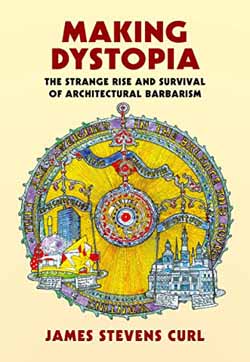 This recent book was brought to my attention by the essay Modern Architecture’s Disastrous Legacy, penned by Stevens Curl himself, and published in the January issue of NER. His 551-page tome should stand proudly beside De architectura (On architecture, or Ten Books on Architecture) by the ancient Roman architect and military engineer Marcus Vitruvius Pollio, dedicated to his patron the emperor Caesar Augustus, and I quattro libri dell’architettura (The Four Books of Architecture) by Andrea Palladio (1508–1580). Stevens Curl’s Making Dystopia adeptly answers the question, What the hell happened since? When one travels to Estonia, among other countries, guides are quick to point out various architectural monstrosities and blame them on the Soviets. Fair enough, but in, say, New Jersey, where were the Soviets? Despite their absence, there are plenty of brutalist horrors there, too. Some reviewers of Stevens Curl’s book have produced fiery hatchet jobs: coming from the mainstream, from (indoctrinated) representatives of the élites who have festooned the world with such aberrant architecture, these confirm how great and valuable, not to mention profoundly informed, this book is.
This recent book was brought to my attention by the essay Modern Architecture’s Disastrous Legacy, penned by Stevens Curl himself, and published in the January issue of NER. His 551-page tome should stand proudly beside De architectura (On architecture, or Ten Books on Architecture) by the ancient Roman architect and military engineer Marcus Vitruvius Pollio, dedicated to his patron the emperor Caesar Augustus, and I quattro libri dell’architettura (The Four Books of Architecture) by Andrea Palladio (1508–1580). Stevens Curl’s Making Dystopia adeptly answers the question, What the hell happened since? When one travels to Estonia, among other countries, guides are quick to point out various architectural monstrosities and blame them on the Soviets. Fair enough, but in, say, New Jersey, where were the Soviets? Despite their absence, there are plenty of brutalist horrors there, too. Some reviewers of Stevens Curl’s book have produced fiery hatchet jobs: coming from the mainstream, from (indoctrinated) representatives of the élites who have festooned the world with such aberrant architecture, these confirm how great and valuable, not to mention profoundly informed, this book is.
Read more in New English Review:
• A Big Little Book on C. S. Lewis
• From Tory Scum to UKIP Fascist
• Anthony Powell’s Dance to the Music of Time: First Movement
Tahiti-Nui: By raft from Tahiti to Chile, by Eric de Bisschop.
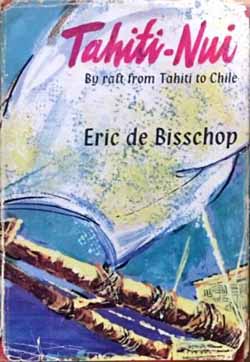 I found this book, published in 1959, a few years ago in the delightful Scarthin Books, in Cromford, Derbyshire, in England. Excerpting from its flap: “When Heyerdahl and his companions made the famous voyage in the Kon-Tiki to support their theory that Polynesia had been discovered and colonised from South America, de Bisschop determined to refute this claim by making a raft voyage in the opposite direction. With four younger companions he built Tahiti Nui [hyphen omitted, G.M.d.S] in Papeete and at the age of sixty-five, and against the advice of all the experts, set forth on the hazardous voyage to Chile.” A publicity stunt? Envy over the worldwide success won by the Kon-Tiki voyage? It is hard to tell by reading this book. De Bisschop was a committed and vastly experienced seafarer, thoroughly French, and a Jesuit to boot. The cocktail of French/Jesuitical hubris is an unannounced delight of sorts, especially in the early chapters, which are more theoretical, before the actual crossing. And how did that go? Not to spoil anything, I’ll just add that a second Tahiti-Nui would eventually be built…
I found this book, published in 1959, a few years ago in the delightful Scarthin Books, in Cromford, Derbyshire, in England. Excerpting from its flap: “When Heyerdahl and his companions made the famous voyage in the Kon-Tiki to support their theory that Polynesia had been discovered and colonised from South America, de Bisschop determined to refute this claim by making a raft voyage in the opposite direction. With four younger companions he built Tahiti Nui [hyphen omitted, G.M.d.S] in Papeete and at the age of sixty-five, and against the advice of all the experts, set forth on the hazardous voyage to Chile.” A publicity stunt? Envy over the worldwide success won by the Kon-Tiki voyage? It is hard to tell by reading this book. De Bisschop was a committed and vastly experienced seafarer, thoroughly French, and a Jesuit to boot. The cocktail of French/Jesuitical hubris is an unannounced delight of sorts, especially in the early chapters, which are more theoretical, before the actual crossing. And how did that go? Not to spoil anything, I’ll just add that a second Tahiti-Nui would eventually be built…
And then there is the other pile of books on my overloaded nightstand. Borges had it right when he stated, “I cannot sleep unless I am surrounded by books.”
«Previous Article Table of Contents Next Article»
__________________________________
Guido Mina di Sospiro was born in Buenos Aires, Argentina, into an ancient Italian family. He was raised in Milan, Italy and was educated at the University of Pavia as well as the USC School of Cinema-Television, now known as USC School of Cinematic Arts. He has been living in the United States since the 1980s, currently near Washington, D.C. He is the author of several books including, The Story of Yew, The Forbidden Book, and The Metaphysics of Ping Pong.
Follow NER on Twitter @NERIconoclast







